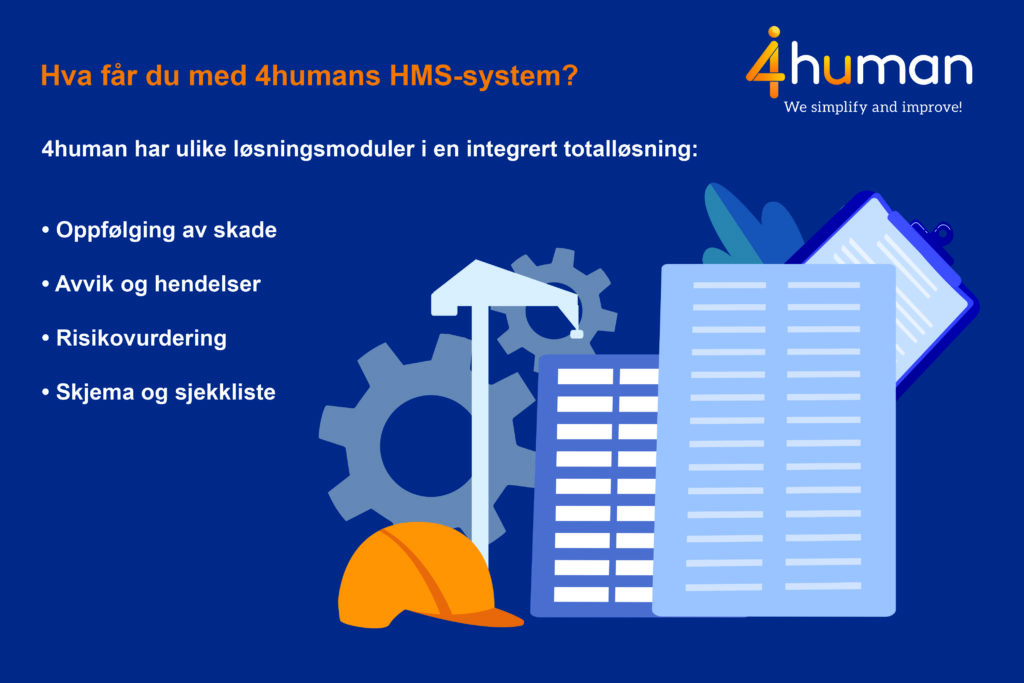HMS
Prevent unwanted situations in the workplace with good HSE work
HSE - Health, Safety and Environment - is about securing and improving the environment in the workplace. One of the key points is to prevent undesirable situations in the workplace and ensure the physical and mental well-being of your employees. As an employer, you are responsible for facilitating a good HSE framework and actively focusing on positive and health-promoting factors in the working environment.
HSE applies to everything within occupational health such as physical andpsychosocial working environment, risks of injuries/accidents and wear and tear, illness, as well as external environmental conditions and safety of employees in the workplace.

What do you get with 4human's HSE system?
With 4human you get various solution modules in an integrated total solution:
- Follow-up of damage
- Deviations and incidents
- Risk assessment
- Form and checklist
In addition, the company has its own HSE handbook, which is a reference work in relation to Norwegian laws and with descriptions of the company's HSE procedures in relation to these.
With our solutions for follow-up, you get key data clearly presented with graphs. You also get an overview of the types of injuries that have been reported in the last period, as well as options for deviation follow-up of incidents and various checklists.
Our solutions include a checklist for safety rounds and an annual cycle of tasks and activities.
Why HSE?
Unfortunate situations or accidents in the workplace can unfortunately occur. It may be a serious workplace accident, or a milder form of accident. Potential hazards and near-accidents occur more frequently than accidents, and it is a goal to uncover causes earlier and thus prevent accidents before they happen. Systematic HSE (Health, Safety and Environment) work handles the company's requirements for safety routines, risk assessments, injuries and deviations. In addition, HSE work will promote:
- Better working environment
- Lower sick leave
- Reduced risk
- Reduced adverse events
In our solutions, you can carry out a good and close follow-up of personal injuries, near misses and other HSE incidents.
HSE and systematic risk
Systematic HSE (Health, Safety and Environment) work handles the company's requirements for safety routines, risk assessment, injuries and deviations. The aim of a risk assessment is to reduce the likelihood of undesirable situations in the form of illness or injury occurring in your workplace.
According to Section 1-1 of the Working Environment Act, companies must, among other things, "ensure a working environment that provides the basis for a health-promoting and meaningful work situation, which provides full security against physical and psychological harm, and with a welfare standard that is at all times in accordance with the technological and social development in society."
A risk assessment should include a mapping of hazards and problems. The scope varies depending on the size of the workplace and the type of work performed.
The following three questions in relation to possible hazards and problems (risks) can be the starting point for a simple risk assessment:
- What can go wrong?
- What can we do to prevent this?
- What can we do to reduce the consequences if something happens?
The risk assessment must be carried out with the employees, safety representatives and employee representatives.
HSE work in practice
The person responsible for the business must ensure that internal control is introduced and exercised in the business and that this is done in cooperation with the employees and their representatives. Employees must participate in the introduction and exercise of internal control ref. § Section 4 of the Internal Control Regulations. The following documentation must be prepared:
- Set targets for health, safety and environment.
- Overview of the company's organization, including how responsibility, tasks and authority for HSE work are distributed
- Identify hazards and issues, including assessing risks and developing plans and actions to reduce risks
- Implement routines to detect, correct and prevent violations stipulated in HSE legislation
- Systematically monitor and review internal controls to ensure that they are working

Who must have an HSE system?
Who is the HSE manager?
In accordance with the Working Environment Act, it is you as the general manager or employer who is responsible for preparing the HSE work. This work cannot be delegated to department heads or other team managers.
By definition, all managers with personnel responsibility are also responsible for ensuring that HSE work functions satisfactorily. In some companies, the management of HSE work is an independent position, like finance manager, product manager, etc. However, the general manager will always have overall responsibility for HSE in the company. To help you on your way, we've created a separateHSE glossaryfor tricky and cumbersome HSE terms.
How to get started with HSE work?
What should an HSE plan contain?
No two HSE plans or action plans are identical, as such a plan depends on the nature and organization of the company. Obviously, having an 8-16 job in an office building is not the same as working on a construction site. Therefore, an HSE plan will always vary, but there are still a number of points you as a manager should include when mapping out an HSE plan or action plan :
- An elaboration of the company's structure, organization and responsibilities.
- A future work plan of the company's most important tasks and projects
- Specific description of measures over any risk work
- Plan of how the company will mitigate risk conditions
- Good routines for handling deviations
Especially in these corona times, it is important to work well with HSE. Working well and thoughtfully with HSE can improve the working environment and reduce absenteeism among employees.
HSE requirements
The following documentation must be prepared:
- Set targets for health, safety and environment
- Overview of the company's organization, including how responsibility, tasks and authority for HSE work are distributed
- Identify hazards and issues, including assessing risks and developing plans and actions to reduce risks
- Implement routines to detect, correct and prevent violations stipulated in HSE legislation
- Systematically monitor and review internal controls to ensure that they are working
HSE deviations
Why HSE courses?
How to create an HSE handbook?
We in 4human has prepared an HSE manual on how to proceed with HSE work. Such a manual can help you prepare a plan and gain control and overview of the HSE work in your business.
HSE rules
HSE measures
Benefits of HSE
- Good and systematic HSE work can:
- Improve the working environment
- Increase productivity in the office
- Less absence
- Increase the reputation of your business
- More attractive to new employees
